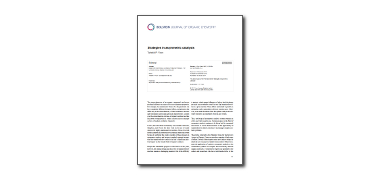Search results
Search for "terpenoid" in Full Text gives 58 result(s) in Beilstein Journal of Organic Chemistry.
Elucidation of the regio- and chemoselectivity of enzymatic allylic oxidations with Pleurotus sapidus – conversion of selected spirocyclic terpenoids and computational analysis
Beilstein J. Org. Chem. 2013, 9, 2233–2241, doi:10.3762/bjoc.9.262
- 1) are suitable substrates for allylic oxidations with PSA. Due to their interesting properties as flavor compounds, we focused our attention to the oxidation of terpenoid spiroethers. As model compounds, unsaturated spiroethers 7, 8, 11 and 12 were synthesized by the intramolecular silyl-modified
- biocatalytic oxidation of vitispirane as a terpenoid with a conjugated double bond and a sterically hindered allylic position (Figure 2). Vitispirane is a flavor compound of vanilla and quince fruit and was identified in grape juice and wine [41][42]. Various syntheses of vitispirane have been reported in the
- ). This allows the isolation of large quantities of the enantiomerically pure derivatives and their detailed olfactory analysis. Conclusion The edible fungus PSA allows efficient allylic oxidations of terpenoid olefins. The oxidation protocols are quite simple, because the lyophilisate of PSA can be used
The chemistry of isoindole natural products
Beilstein J. Org. Chem. 2013, 9, 2048–2078, doi:10.3762/bjoc.9.243
- zanamivir [141]. The putative biosynthesis of 156, which contains a pentacyclic ring system with a cis-fused decalin is depicted in Scheme 21. Farnesyl pyrophosphate (167), which originates from the terpenoid pathway through the condensation of dimethylallyl pyrophosphate (DMAPP, 165) with two units of
Natural products in synthesis and biosynthesis
Beilstein J. Org. Chem. 2013, 9, 1897–1898, doi:10.3762/bjoc.9.223

- examples of comparing natural to artificial systems it is their interplay that may provide the best solutions to some of the most urgent problems of our time. A perfect example is artemisinin, a terpenoid natural product from Artemisia annua, which is highly efficient in the treatment of malaria. The
Volatile organic compounds produced by the phytopathogenic bacterium Xanthomonas campestris pv. vesicatoria 85-10
Beilstein J. Org. Chem. 2012, 8, 579–596, doi:10.3762/bjoc.8.65

- only aromatic components found in the bouquet, while geranylacetone (39) and a later-eluting yet unidentified compound, showing a mass spectrum somewhat resembling that of farnesylacetone, represented terpenoid structures among the volatiles produced by X. c. pv. vesicatoria 85-10. PTR–MS of highly
Efficient oxidation of oleanolic acid derivatives using magnesium bis(monoperoxyphthalate) hexahydrate (MMPP): A convenient 2-step procedure towards 12-oxo-28-carboxylic acid derivatives
Beilstein J. Org. Chem. 2012, 8, 164–169, doi:10.3762/bjoc.8.17
- products as (±)-muricatacin [8][9] or the three hydroxylactones found in the mushroom Mycoleptodonoides aitchisonii [10]. Terpenoid δ-hydroxy-γ-spirolactones have been found to act as significant feeding deterrents to the lesser mealworm Alphitobius diaperinus [11]. In particular, oleanane-type
Tertiary alcohol preferred: Hydroxylation of trans-3-methyl-L-proline with proline hydroxylases
Beilstein J. Org. Chem. 2011, 7, 1643–1647, doi:10.3762/bjoc.7.193
- approach whose potential has not yet been fully exploited is the stereospecific hydroxylation of tertiary alkyl moieties with oxygenases. Most oxidations to tertiary alcohols described so far were observed during degradation of steroids and other terpenoid bioactive compounds by microbial whole cells [10
Acid- mediated reactions under microfluidic conditions: A new strategy for practical synthesis of biofunctional natural products
Beilstein J. Org. Chem. 2009, 5, No. 40, doi:10.3762/bjoc.5.40
- scale-synthesis of the immunostimulating natural terpenoid, pristane, of about 500–1000 kg in a year [29]. In this account, we review these acid-mediated reactions and discuss the new aspects of using microfluidic systems for controlling the hitherto difficult reactions in conventional organic synthesis
A simple route for renewable nano- sized arjunolic and asiatic acids and self- assembly of arjuna- bromolactone
Beilstein J. Org. Chem. 2008, 4, No. 24, doi:10.3762/bjoc.4.24
- –0.80 (terpenoid H's, 20H), 1.03 (s, 3H), 0.91 (s, 3H), 0.905 (d, J = 9.0 Hz, 3H), 0.803 (d, J = 6.0 Hz, 3H), 0.72 (s, 3H), 0.52 (s, 3H). 13C-NMR (150 MHz, DMSO-d6) δ 178.7, 138.5, 124.7, 75.7, 67.7, 64.1, 52.6, 47.2, 47.1, 46.2, 42.7, 42.0, 37.5, 36.6, 32.4, 31.5, 30.4, 29.2, 27.7, 25.6, 24.0, 23.5























































































